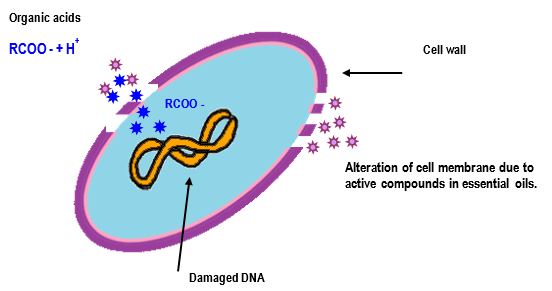INTRODUCTION
Streptococcal infections are one of the leading causes of economic and production losses in pig farming (1, 4).
These infections are caused by the Streptococcussuis bacterium, whose natural habitat is swine (mainly in the upper respiratory, digestive and genital tracts), where it represents the most important primary pathogen (1, 2). Exist 35 recognized serotypes of S. suis, but serotypes 2, 1/2, 7 and 9 are the ones most frequently associated with disease (1, 4).
Morbidity and mortality in farms vary, depending on the way the disease clinically appears on the farm and whether its onset is associated with other diseases on site. When the symptoms are associated with nervous clinical disorder, morbidity usually ranges between 5 and 10% but in this case, mortality rates will reach 100% of the affected animals. In contrast, other forms of clinical symptoms may produce morbidity rates of up to 70-80%, in which cases mortality is almost non-existent (1, 2).
The disease may appear in various clinical forms - meningitis, arthritis, and respiratory septicemia (1, 2). (Figure 1).
(Photo 1: Purulent arthritis caused by S. suis in a piglet in the farrowing stage)
To control the disease, knowledge of its epidemiology is essential. The transmission of the disease is initially vertical, from the sow to the piglet, thereafter to be transmitted horizontally between piglets in maternity units.
Sows - in most cases, healthy carriers - transmit the infection to piglets in the early hours of delivery through vaginal fluids as well as through the skin and saliva in the hours after birth. Similarly, horizontal transmission is possible among piglets and through contaminated fomites (1, 2).
The disease usually appears abruptly in piglets between one and two weeks after weaning, but it can also appear in maternity units. The moment when the piglet enters the fattening unit is of a special risk of the disease. Stress factors, nutritional imbalances, the incidence of other diseases, nutritional errors and generally poor farm management are key factors that predispose the onset of the disease. Abundant literature underlines the relationship between a higher streptococcal infection rate in piglets from herds that have undergone an outbreak of Porcine Reproductive and Respiratory Syndrome (PRRS) (1, 2).
Traditionally, control of the disease was achieved by using antimicrobials in sows and piglets, as well as applying more stringent conditions of hygiene and farm management practices (1, 3). Monitoring and examining new animals arriving at the farm that can act as healthy carriers is vital.
At present, eradication of S. suis infections on commercial pig farms is practically unfeasible. The goals of current control measures are to maintain the health status, without any appearance of animals with clinical symptoms or with an onset rate within normal limits.
However, although effective antimicrobial solutions exist for this bacteria, their continuous usage is the object of widespread debate nowadays. S. suis is receiving increasing worldwide attention, not only because of its zoonotic role but also because of its possible involvement in antimicrobial resistance (3, 4). In this regard, it has been observed that 85% of the porcine isolates of S. suis are resistant to macrolides, lincosamides, tetracyclines and sulfonamides (4), with the consequent impact on the appearance of therapeutic failure and the spread of resistance.
HYGEN PRO® STREPT PHYTOBIOTIC TO PREVENT STREPTOCOCCAL INFECTIONS IN PIGS
HYGEN PRO® STREPT is a phytobiotic food supplement specifically designed to control infections caused by S. suis in pigs.
Various combinations of plant extracts, essential oils and medium and short chain fatty acids were analyzed to optimize the composition of the HYGEN PRO® STREPT phytobiotic. The product’s design was based both on results of in-vitro and in-vivo efficacy versus S. suis and seeks to obtain improvements in piglet performance. In this regard, the combination of the various active ingredients is of special interest given the way it levers their synergy in both its bactericidal action and in its quest for a greater growth-enhancing effect. In fact, it is well known that the synergy between essential oils and short and medium chain fatty acids increases the bactericidal efficacy of the latter by facilitating penetration through the cell wall of the bacteria (Figure 2).

The evaluation of the in vitro efficacy of the product was carried out by the Center for Veterinary Health Surveillance (VISAVET) at the Complutense University of Madrid. Minimum Inhibitory Concentration (MIC) of the product was determined by agar diffusion test and compared to clinical isolates of S. suis taken from pig joints, brains and hearts.
The results (Table 1) show that all strains tested revealed an MIC with HYGEN PRO® STREPT of between 1.5 mg/ml and 3 mg/ml.
These results confirm that the tested isolates were sensitive in vivo to commercial doses of the product used in pigs.
Table 1. MIC of 8 clinical isolates of S. suis of porcine origin with HYGEN PRO® STREPT
Studies carried out at commercial farms show how with proper management of sows and in the weaning stages and transition, together with the usage of recommended doses of HYGEN PRO STREPT, is possible to reduce the pressure of infection and minimize the appearance of streptococcal infections both in maternity and in the transition stage.
To achieve that goal, apart from improving sow management, nutrition and biosecurity, the recommendation is to supplement 2 kg/mt of the product in the diet for lactating sows for and to keep that supplement throughout the lactation phase, additionally to supplement piglets’ feed with a dose of 2-3 kg per ton, depending on whether or any acidifying agents are used in the feed, continue up to 70 days of life. In farms with incidence of infection in the fattening units, the product has shown to be effective at a dosage of 2 kg per ton of compound feed without any need to use other specific medication to solve the problem in question.
Apart from the health improvements seen on farms, other production and economic advantages have also been noted, based on improving the feed conversion ratio and decreasing the incidence of enteric processes.
CONCLUSION
HYGEN PRO® STREPT phytobiotic applied in sows and piglets at the recommended doses is an effective alternative to the continuous use of antibiotics to control streptococcal infection in pigs. Furthermore, the product provides for better intestinal health which has a significant impact on pig performance.
BIBLIOGRAPHY
- Streptococcos suis en ganado porcino. Contreras Olmo, JM. Ganadería (2002) Nº 16, pp. 44-47
- Streptococcus suis: Un patógeno con creciente interés para cerdos y humanos. Sáez Nieto JA. Profesión veterinaria (2006), Vol. 16, Nº. 64, pp. 38-40
- Antimicrobial resistance and prudent drug use for Streptococcus suis. Varela NP, Gadbois P, Thibault C, Gottschalk M, Dick P, Wilson J. Animal Health Research Reviews (2013), 14, pp. 68-77.
- Streptococcus suis, an important pig pathogen and emerging zoonotic agent-an update on the worldwide distribution based on serotyping and sequence typing. Goyette-Desjardins G, Auger JP, Xu J, Segura M, Gottschalk M. Emerg Microbes Infect. (2014) Jun;3(6) pp. e45.
Figure 2. Outline of the synergetic action between fatty acids and essential oils








